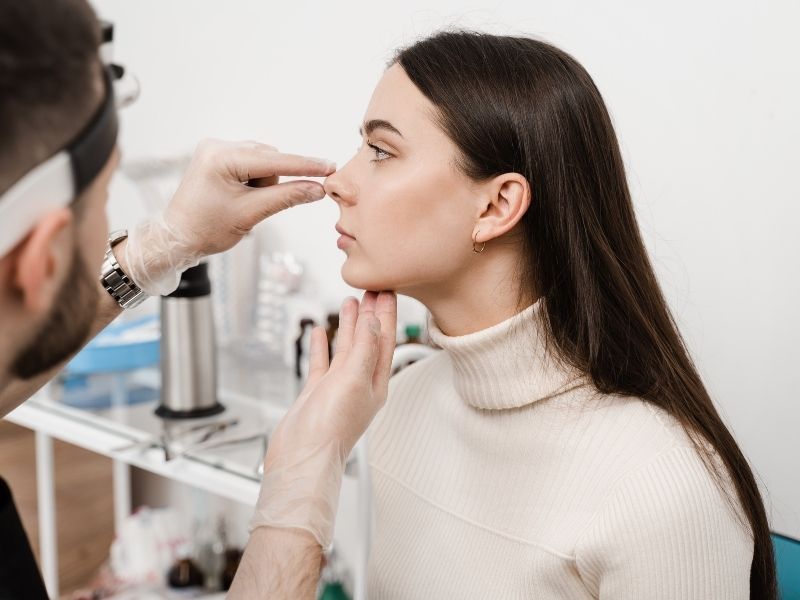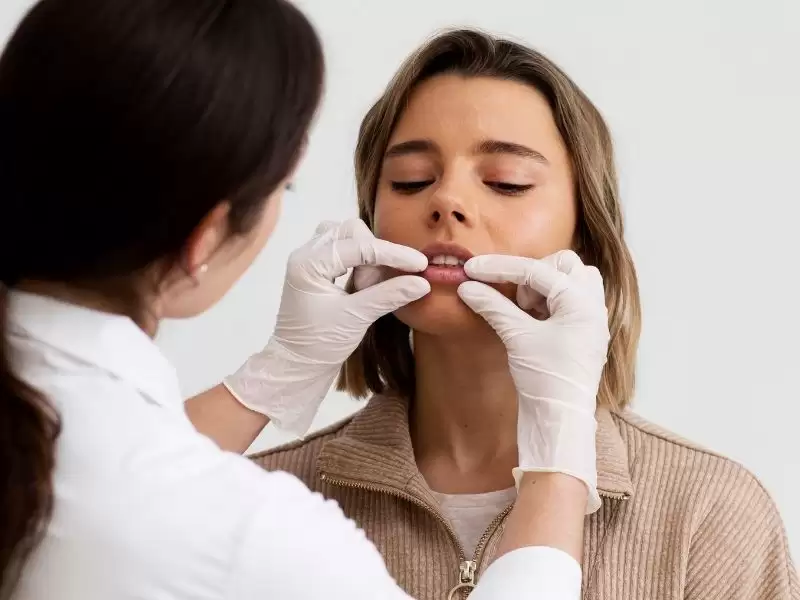n the closed rhinoplasty technique, the incision is made inside the nose, and no external intervention is applied. In the open technique, a small incision is made at the tip of the nose. Contrary to common belief, in open nasoplasty, no incision is made on the nasal skin itself.
Who Is Rhinoplasty For?
The nose, due to certain congenital anatomical factors, may have structural deformities, and over time or as a result of trauma, additional deformations can occur. These structural irregularities can lead not only to aesthetic concerns but also to physical breathing difficulties. In such cases, rhinoplasty becomes a necessary procedure.
Situations that may require rhinoplasty due to both aesthetic and functional reasons include:
- Bony or protruding nasal structure
- Wide or asymmetrical nostrils
- Drooping nasal tip
- Deviated nasal bone
- Cartilage deformities
- Asymmetrical nasal shape
Important Considerations in Rhinoplasty
The primary goal of rhinoplasty surgery is to achieve a natural and harmonious appearance.
The goal of rhinoplasty is to create such a natural appearance that it is nearly impossible to tell a surgery has been performed. Achieving a natural look in nasal aesthetics is possible only when the patient’s expectations are harmonized with their unique facial and bone structure.
There are two essential factors to ensure successful outcomes in rhinoplasty procedures:
- A nasal design that suits the individual’s face and overall facial proportions must be created. The surgeon’s aesthetic understanding, medical evaluations, and the patient’s expectations should align in this process.
- The preoperative plan must be executed by the surgeon with precision and expertise.
The success of a rhinoplasty design depends on the patient achieving both functional and aesthetic satisfaction — resulting in a nose that looks natural, fits harmoniously with facial features, and allows comfortable breathing.
Things to Consider Before Rhinoplasty Surgery
Before undergoing rhinoplasty, the desired nasal shape should be clearly defined, and expectations must remain realistic. During the procedure, the functional aspects of the nose should never be compromised.
After a detailed medical examination, the surgical plan is prepared, determining whether an open or closed approach, along with nasoplasty or rhinoplasty, will be performed. When designing the new nasal shape, harmony with the rest of the face is crucial. Factors such as nasal size, curvature, and proportional balance with other facial features are carefully evaluated. The design should maintain naturalness and avoid any artificial appearance by considering the nose’s relationship with surrounding structures.
Before surgery, multiple photographs of the patient are taken from different angles and uploaded into a digital system. These images are analyzed to identify areas that require correction. The patient’s expectations and desired nasal appearance are also assessed to finalize the most suitable design.
Things to Consider After Rhinoplasty Surgery
During the recovery period, the patient should rest with the head elevated and avoid direct exposure to sunlight. The face must be protected from impacts such as falls or bumps. Any postoperative pain can be managed with painkillers prescribed by the doctor. Additionally, the protective nasal bandage applied after surgery should not be tampered with under any circumstances.
What Are the Surgical Techniques Used in Rhinoplasty?
There are many different surgical techniques described for rhinoplasty, and surgeries are often performed using one or a combination of these methods. Every person has a unique nasal anatomy — therefore, each operation must be tailored to individual structural characteristics.
The skin may be thick or thin, dry or oily; the nasal bones may be dense or delicate; and the cartilage can be elastic, rigid, or soft. Some noses may present deviations or depressions. For each of these variations, a personalized treatment strategy must be developed.
The fundamental principle is to correct the undesired anatomical structures — the underlying components — and ensure they contribute positively to the overall appearance. The final nasal form is determined through collaboration between the patient’s expectations and the surgeon’s professional judgment.
In some cases, supportive techniques are required to strengthen weak or deficient areas. These reinforcements are typically made using small cartilage grafts harvested from within the nose. From hundreds of available methods, the surgeon selects the most appropriate one to create the nasal framework. The skin then naturally reshapes over this new structure, defining the final nasal contour.
Among the general public, the two most commonly known rhinoplasty techniques are the open and closed approaches.
1. Open Rhinoplasty Technique
In the open rhinoplasty technique, a small incision measuring approximately 3–4 mm is made at the base of the columella — the area between the two nostrils. Several incision shapes are described in the literature, with horizontal, step-shaped, V-shaped, and seagull (martı)–shaped cuts being the most commonly used.
Through this incision, the nasal tip skin is carefully lifted, following the nasal cartilage structure. This allows the surgeon to clearly visualize the underlying anatomy of the nasal tip and perform the necessary corrections with precision. The nasal tip and cartilages are then reshaped — excess cartilage is removed, while weak areas are reinforced using grafts or supportive sutures when needed.
Under direct vision, the nasal hump (the bony and cartilaginous prominence on the bridge of the nose) is reduced by cutting and filing it down. Depending on the patient’s preference and facial harmony, the nasal bridge can be reshaped to appear straight or slightly curved.
This approach provides maximum visibility and control for the surgeon, making it especially suitable for complex cases or revision rhinoplasty procedures.
The open roof that forms during the procedure is then reconstructed by bringing the lateral nasal walls closer together, restoring the nasal framework and giving it its final shape.
Important points to consider before surgery:
- Blood-thinning medications that may increase bleeding should be discontinued before the operation.
- Stopping the use of such medications in advance helps minimize the risk of bruising after surgery.
- If you experience breathing difficulties, the underlying causes are identified and corrected during the procedure.
- Carefully following all preoperative instructions provided by your surgeon ensures a smoother and more comfortable recovery period.
What Are the Advantages of the Open Rhinoplasty Technique?
- In rhinoplasty operations performed with the open technique, since the surgical field is wider, it provides the opportunity to make more changes inside the nose.
- In revision rhinoplasty surgeries, if major problems are present, the open technique is especially recommended.
2. Closed Rhinoplasty Technique
Among the many surgical techniques available in rhinoplasty, one of them is the closed technique. In this technique, all incisions are made inside the nose. By entering through the nostrils, the nasal tip cartilages are shaped, and the nasal tip is given the desired form. Depending on the location, incision techniques from the front, back, or inside of the tip cartilages have been defined.
Through these entry points, the skin is separated from the skeletal structures, and the anatomical structures are revealed. The hump structure called the nasal dorsum is reached, and the excess cartilage and bone are removed to give a straight or curved shape according to the desired result. Then, with small incisions made from the inside, the side walls are cut, and the nasal roof is narrowed. In addition, the closed rhinoplasty technique can also be used in revision rhinoplasty surgeries. That is, if the patient has previously undergone a rhinoplasty operation and there is no major problem at the nasal tip, the closed technique can be used.
During the postoperative healing process, the patient is followed up with a plastic splint for one week, and only tapes are applied for another week. After a total of about two weeks, all dressings are removed.
Rhinoplasty, also known as nose aesthetic surgery, is a procedure performed in cases where there are structural or functional problems in the nose.
In the closed nose surgery, the procedure is performed without making any incisions on the nose, by entering through the nostrils. Therefore, there is no risk of leaving any scars, and it is especially preferred by patients who are concerned about visible scarring.
What Are the Advantages of the Closed Rhinoplasty Technique?
- In rhinoplasty surgeries performed with the closed technique, the healing process is quite fast.
- Since no blood vessels or nerves are cut during closed rhinoplasty surgeries, there is no feeling of numbness at the tip of the nose.
- Recovery begins within 6 weeks after the surgery and is usually completed within approximately 1 year.
- The fact that the scar is not visible from the outside makes the closed technique a more advantageous option.








